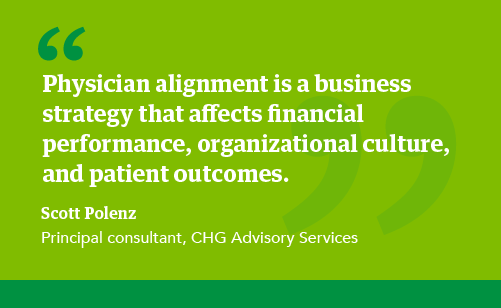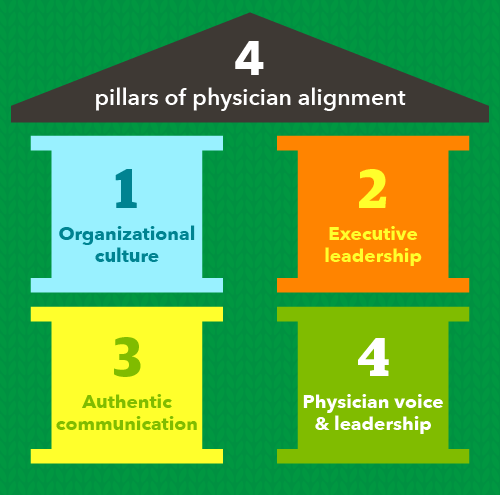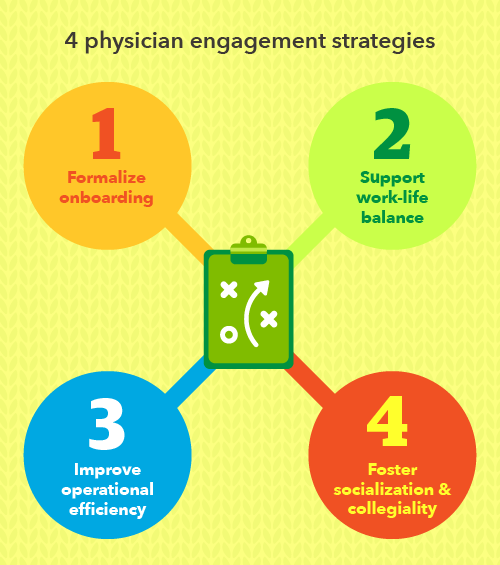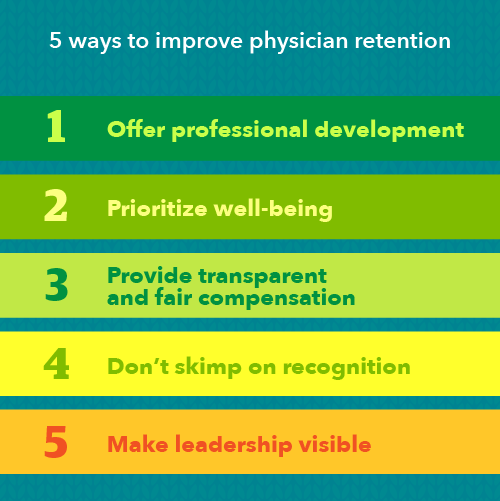
Do physicians in your organization feel valued? Or do they feel like commodities? Don’t answer too quickly: You might not know until they give their notice.
Physicians who feel respected and whose values match the organization’s mission and culture are more likely to remain loyal to their health system, explains Scott Polenz, principal consultant of Advisory Services at CHG Healthcare. And that alignment is the key to successful recruitment and retention in healthcare.
Often, alignment gets brushed off as a “soft skill.” Don’t believe it, Polenz warns: Physician alignment is a business strategy that affects financial performance, organizational culture, and patient outcomes.

The business case for alignment
Healthcare staffing challenges are widespread, and competition for talent is intensifying. A June 2025 AMA survey of physicians found that 32% reported a moderate or high interest in leaving their current positions. Of those, about 13% will actually leave, Polenz estimates. For an organization with 1,000 physicians, this can lead to $150 million annually in direct expenses and lost clinical revenue.
Here are just a few of the numbers:
- $1.2 million: Estimated cost of losing a single physician; for surgical specialists, that can jump to several million dollars if the role remains vacant.
- $6 million: Additional recruitment costs the average healthcare organization will face in 2025 compared to 2024, according to CHG Healthcare analysis.
- 226 days: Time it can take to fill a specialty care position, leading to as much as $4.5 million in lost revenue.
- 189 days: Time it can take to fill a primary care position, leading to up to $1.9 million in lost revenue.
Sources: American Medical Association, CHG Healthcare, Weatherby Healthcare
It’s not just cost avoidance: Engaged physicians can be 26% more productive, generating hundreds of thousands of dollars in additional revenue each year. Overall, Polenz estimates a 10:1 ROI from preventing costly departures and improving productivity.
This makes alignment worth “millions and millions of dollars,” he says.
Reduce turnover and improve physician retention: 8 solutions for healthcare organizations
Four pillars of physician alignment
Aligned physicians are engaged and feel connected to your organization’s mission, culture, and leadership. That inspires them to deliver better care, feel greater job satisfaction, and stay longer, Polenz says, making alignment a powerful strategy for physician retention. It's built on four pillars.

1. Organizational culture
Culture shapes every aspect of a physician’s work experience, from professional satisfaction to patient outcomes. As healthcare leadership guru Quint Studersaid, “Culture outperforms strategy every time; and culture with strategy is unbeatable.”
Your organizational culture may sound good on paper, but does it truly reflect its stated mission and values in day-to-day practice? You can find out through surveys and pulse checks. But you have act on that feedback, Polenz says.
2. Executive leadership
Physicians must believe in the leadership’s vision and integrity. They need to see that leaders are genuine and transparent, that decisions are grounded in sound reasoning, and that leaders understand the challenges they face. When these three elements are present, alignment feels natural—and engagement follows.
3. Authentic communication
“Communication is not about a great PowerPoint slide or a wonderfully written memo. It’s about connection and authenticity,” Polenz explains.
Clear, authentic communication from leadership to physicians builds trust, strengthens collaboration, and has a direct impact on patient outcomes. Memos and slide decks keep operations running smoothly, but engagement requires authentic stories. Communicate the “why” behind major decisions and use real examples of people and patients affected.
4. Physician voice and leadership
When physicians have a voice in decision making, they’re more likely to feel valued and engaged. They move from feeling like commodities to becoming co-leaders of organizational transformation.
Reframe your recruiting strategy: Adapt compensation to support flexibility and improve retention
Physician engagement strategies: From alignment to action
Engagement is the expression of alignment, fueling commitment, collaboration, and performance. Polenz shares several ways to cultivate it.

1.Formalize onboarding
A successful onboarding program that reinforces mission, values, and organizational culture from day one makes physicians feel welcomed and valued. As the AMA puts it, “Physician onboarding isn’t a formality—it’s a cultural linchpin.”
It also connects new physicians with mentors or peer networks, providing access to resources and support. For instance, Polenz advised a healthcare organization to pair every new physician with a peer mentor within their first week. The result? A 20% drop in early turnover and higher engagement scores across the first year.
2. Support work-life balance
Physicians want to work for organizations that support balance and adaptability. Flexible scheduling—such as four-day workweeks, telehealth opportunities, and job-sharing models—is important. So is access to wellness and mental health resources.
Focus on well-being: 5 ways to increase retention
3. Improve operational efficiency
Operational efficiency has a direct impact on morale and employee retention. Reducing paperwork allows physicians to focus on patient care, as does allowing for autonomy in clinical decision-making and scheduling.
4. Foster socialization and collegiality
Social integration significantly reduces feelings of isolation, especially for new and early-career physicians, Polenz says. He recommends facilitating mentorship programs and structured peer networking; hosting events such as retreats, dinners, and other social gatherings; and including spouses and partners. “A happy spouse or partner is going to help a physician or APP be happier at their job,” says Polenz.
What do physicians think? 2025 Physician Sentiment Survey
The benefits of physician engagement
Here are just a few of the benefits of physician engagement:
- Improved patient care by fostering better communication, adherence to best practices, and overall health outcomes
- Strengthened collaboration and innovation among healthcare teams, encouraging knowledge sharing and development of new solutions
- Reduced physician burnout and turnover, supporting a more stable and satisfied workforce
- Enhanced organizational performance, including financial results, patient satisfaction, and overall reputation
- Increased patient engagement by empowering patients to actively participate in their own care
- Lowered costs through improved efficiency, retention, and reduced recruitment and training expenses
- Promotes the Quadruple Aim by improving patient experience, population health, reducing costs, and enhancing provider experience
Physician retention strategies: Sustaining long-term commitment.
Sustained alignment requires organizations to invest in growth, recognition, and well-being, demonstrating to physicians that their contributions are valued and their careers have long-term potential.

1. Offer professional development
Physicians want to know that their careers have room to grow. Offering leadership training, CME opportunities, and mentorship shows commitment to their long-term success—not just their day-to-day performance.
2. Prioritize well-being
Burnout isn’t just a personal issue—it’s an organizational risk. Formal wellness programs and visible leadership support send a clear message: Physician well-being is a strategic priority, not an afterthought.
3. Provide transparent and fair compensation
Ensure transparency and fairness by clearly explaining bonus structures and productivity metrics. Link incentives to engagement and quality outcomes; when incentives focus solely on volume, physicians may feel pressured to prioritize throughput over patient care, leading to burnout and disengagement.
4. Don't skimp on recognition
Authentic, timely recognition strengthens morale and cultivates loyalty, whether it’s a public milestone celebration or personal praise from leadership.
5. Make leadership visible
To cultivate trust, show up. Do rounds. Visit physician teams, ask candid questions, listen deeply, and respond in real time. Your physical presence builds rapport and drives home the message that alignment isn’t abstract—it’s lived leadership, Polenz counsels.
Walking the halls gives hospital leaders a glimpse of the real challenges physicians face. Executive leaders at one health system began visiting care teams weekly—not to check boxes or check up on them, but to ask what was working and what wasn’t. These conversations uncovered workflow issues that were quickly resolved, leading to a noticeable improvement in morale and engagement.
Recruit strategically: How to hire physicians in an increasingly competitive market
Establish an Office of Physician and APP Relations
Polenz strongly advocates for establishing an Office of Physician and APP Relations to give them a central hub for all their concerns.
You can’t walk into executive leadership and demand they establish one, but you can put together a business case, using the data provided in this article plus data from your own organization.
The office serves multiple functions.
Tracking the data
Its specific structure and functions will depend on each organization. Typically, such an office will track key data such as engagement, turnover, onboarding progress, and trust levels, providing leadership with practical insights. Organizations should monitor KPIs such as engagement survey results, trust scores, burnout indices, and turnover rates to evaluate the health of physician relationships.
Building culture
The office can also take a leadership role in cultural initiatives, whether that means designing creative recognition programs or finding fresh ways for physicians and APPs to connect and support each other. It plays an important part in physician leadership development as well, coaching emerging physician leaders to strengthen alignment and foster effective teamwork.
Providing a one-stop shop
Collaborating closely with HR, recruitment, and operations, this office helps ensure that every stage of the physician and APP experience supports both individual growth and the organization’s goals. By bringing together onboarding, HR, credentialing, well-being, mentorship, leadership development, and recognition under one roof, the office can create a cohesive strategy that promotes accountability and delivers measurable results.
Building physician alignment for lasting impact
Aligning physicians with mission, culture, and leadership is essential for long-term retention, engagement, and cost-effective healthcare delivery.
It's a discipline that touches every aspect of the physician journey, starting with recruitment. “There is no silver bullet that works for all healthcare organizations,” Polenz says. But by embedding alignment into recruitment, onboarding, professional development, and leadership practices, you can strengthen culture, reduce costly turnover, and improve overall performance.
CHG can provide your healthcare facility with the doctors, advanced practiceprofessionals, and allied healthcare professionals you need to deliver the best care for your community. Contact us at 866.570.9920 or email ecs.contact@chghealthcare.com.